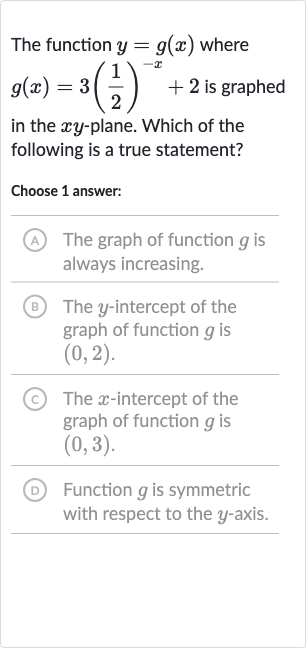AI tutor
Welcome to Bytelearn!
Let’s check out your problem:

The function where is graphed in the -plane. Which of the following is a true statement?Choose answer:(A) The graph of function is always increasing.(B) The -intercept of the graph of function is .(C) The -intercept of the graph of function is .(D) Function is symmetric with respect to the -axis.
Full solution
Q. The function where is graphed in the -plane. Which of the following is a true statement?Choose answer:(A) The graph of function is always increasing.(B) The -intercept of the graph of function is .(C) The -intercept of the graph of function is .(D) Function is symmetric with respect to the -axis.
- Analyze function behavior: Analyze the function to determine its behavior.The function is an exponential function with a base of raised to the power of , and then multiplied by and added to . The negative exponent indicates that as increases, the value of increases because is the same as . This means the function is increasing as increases.
- Find y-intercept: Determine the y-intercept of the function .To find the y-intercept, we set to in the function .The y-intercept of the graph of function is , not .
- Find x-intercept: Determine the x-intercept of the function .To find the x-intercept, we set to and solve for .This equation does not have a real solution because is always positive, and therefore cannot equal . Hence, there is no x-intercept.
- Check for y-axis symmetry: Check for symmetry with respect to the y-axis.A function is symmetric with respect to the y-axis if for all . Let's check if this is true for .Since is not equal to for all , the function is not symmetric with respect to the y-axis.
